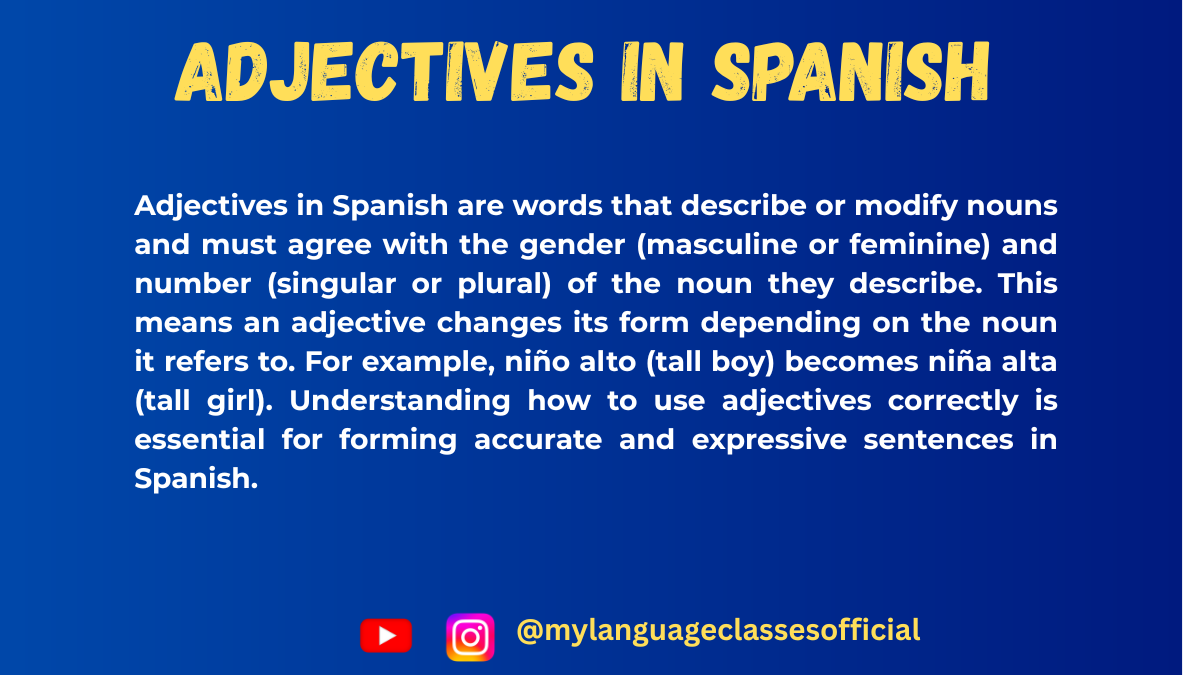Your cart is currently empty!
Tag: number agreement in Spanish
-

Adjectives in Spanish
Learning Spanish is a rewarding journey, and understanding the agreement and placement of adjectives is a key step in mastering the language. Unlike in English, where adjectives are generally static in form and placement, Spanish adjectives change depending on gender, number, and often their position within a sentence. Let’s dive into the rules and nuances of this fundamental grammar topic.
1. Adjective Agreement: Gender and Number
In Spanish, adjectives must agree in gender (masculine or feminine) and number (singular or plural) with the noun they describe. Here’s how:
Gender Agreement
- Masculine singular nouns take adjectives ending in “-o”.
- Example: un libro interesante (an interesting book)
- un libro rojo (a red book)
- Feminine singular nouns take adjectives ending in “-a”.
- Example: una casa bonita (a beautiful house)
- una chica inteligente (a smart girl)
- Adjectives that end in “-e” or a consonant do not change for gender.
- Example: un estudiante amable (a kind student, masculine)
- una estudiante amable (a kind student, feminine)
Number Agreement
- To make adjectives plural:
- Add -s if the adjective ends in a vowel.
- Example: chico simpático → chicos simpáticos
- Add -es if the adjective ends in a consonant.
- Example: mujer feliz → mujeres felices
- Add -s if the adjective ends in a vowel.
2. Placement of Adjectives: Before or After the Noun?
Unlike English, where adjectives almost always precede the noun, Spanish allows adjectives to appear both before and after the noun, depending on the type of adjective and the meaning.
Adjectives that Generally Follow the Noun
Most descriptive adjectives follow the noun:
- Example: una flor hermosa (a beautiful flower)
- un coche nuevo (a new car)
Adjectives that Precede the Noun
Certain adjectives, especially those indicating quantity, order, or inherent qualities, come before the noun:
- Example: muchos amigos (many friends)
- primer día (first day)
- la blanca nieve (the white snow; “white” is a poetic or inherent quality here)
Adjective Placement and Meaning
Some adjectives change their meaning depending on placement:
- Example: un hombre grande (a big man) vs. un gran hombre (a great man)
- una mujer pobre (a poor woman, economically) vs. una pobre mujer (a pitiable woman)
3. Articles and Adjectives
Adjectives in Spanish often work closely with definite (el, la, los, las) or indefinite articles (un, una, unos, unas). Keep these rules in mind:
- The article must match the noun in gender and number.
- Example: el chico alto (the tall boy)
- las chicas altas (the tall girls)
- When using more than one adjective, ensure both agree with the noun:
- Example: un perro grande y amistoso (a big and friendly dog)
- unas casas bonitas y cómodas (some beautiful and comfortable houses)
4. Common Exceptions and Tips
Invariable Adjectives
Some adjectives, particularly those borrowed from other languages (like beige or naranja), do not change form for gender or number.
- Example: unos sofás beige (some beige sofas)
Adjectives of Nationality
Adjectives of nationality often end in a consonant and follow specific rules for gender and number agreement:
- Example: un hombre español (a Spanish man) → unos hombres españoles
- una mujer francesa (a French woman) → unas mujeres francesas
Adjectives with Shortened Forms
Some adjectives have special shortened forms when placed before singular masculine nouns:
- Example: bueno → buen: un buen amigo (a good friend)
- malo → mal: un mal día (a bad day)
5. Practice Makes Perfect!
Understanding these rules is just the beginning. To truly master adjective agreement and placement in Spanish, practice is essential. Read texts in Spanish, listen to native speakers, and try forming your own sentences. Pay attention to how adjectives interact with the nouns they describe, and don’t be afraid to make mistakes—they’re part of the learning process!
Here’s a quick exercise:
- Translate the following into Spanish, ensuring proper agreement and placement:
- A red apple
- Some intelligent students
- The happy women
- Describe your surroundings in Spanish using at least five adjectives. Pay attention to gender, number, and placement.
By understanding and practicing these principles, you’ll gain confidence in your Spanish skills and bring your sentences to life with vivid, descriptive language. ¡Buena suerte!
If you enjoyed this lesson, be sure to check out more posts like this on my blog at My Language Classes. Don’t forget to subscribe my YouTube channel and follow me on Instagram for the latest language learning tips and lessons. Leave a comment below to share your thoughts, or ask any questions you have.
Happy learning! 😊
- Masculine singular nouns take adjectives ending in “-o”.
